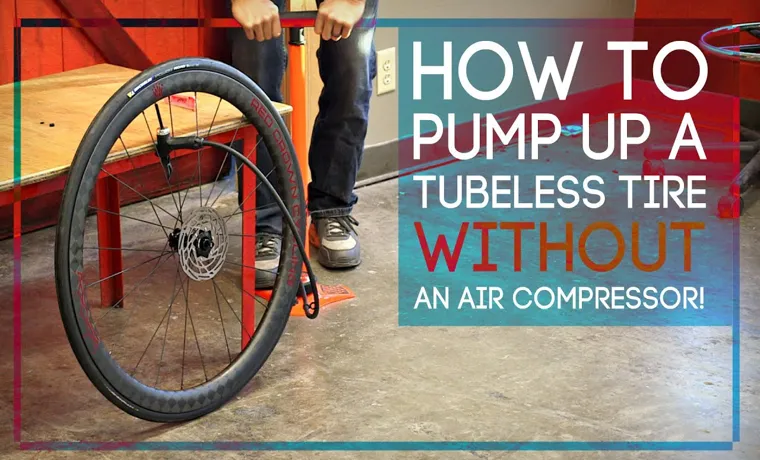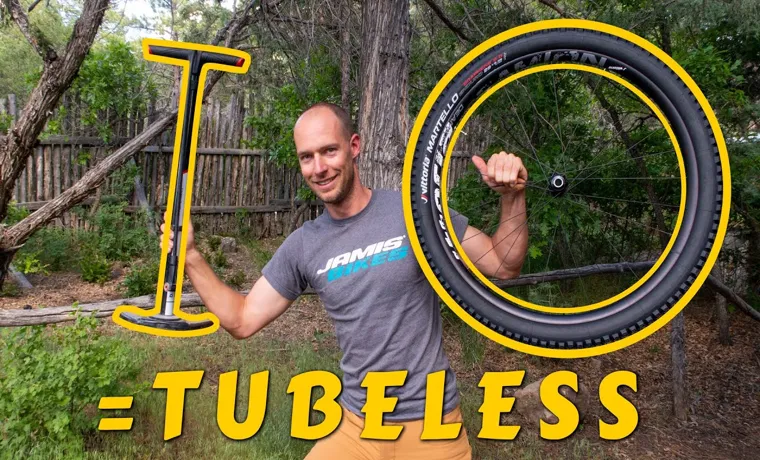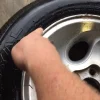So, you’ve purchased a new tubeless tire for your bike and you’re excited to take it out for a spin. However, you realize that you don’t have a compressor to seat the bead onto the rim. Don’t worry because there are other ways to get the job done without a compressor.
In this blog post, we will discuss easy methods to seat a tubeless tire without a compressor, so you can start cycling again in no time. Trying to seat a tubeless tire by hand can be a daunting task, especially if you’re a beginner. But with the right approach, you can make it an easy and manageable task.
However, it’s important to understand that a tubeless tire relies on an airtight seal between the tire and the rim, so you need to be careful not to damage it during the process. In this post, we will cover different ways you can use a floor pump, a CO2 cartridge, or even some soapy water to get the job done without a compressor. We’ll also discuss some tips and tricks to make the process smoother.
With a little bit of patience and determination, you can seat a tubeless tire without any extra tools. So, let’s get started!
Table of Contents
What You Will Need
If you’ve ever had to seat a tubeless tire without a compressor, you know it can be a bit trickier than with one. Fear not, though, because it’s definitely still doable with a few key tools and techniques. First and foremost, you’ll need a tubeless tire sealant, which will help lubricate the tire and rim and increase the chances of it seating properly.
You’ll also need a high-volume floor pump, which is strong enough to create the necessary amount of air pressure. One helpful tip is to remove the valve core from the tire before attempting to seat it, as this allows for maximum airflow. Additionally, a good technique is to start by setting the tire bead in the rim’s deepest section, then pushing down on the opposite side of the tire to force it into place.
Remember that patience is key, and it may take a few tries to get the tire fully seated. With some determination and the right tools, though, you can definitely seat a tubeless tire without a compressor.
Tubeless Tire Sealant
Tubeless tire sealant is a popular choice for cyclists who want to avoid punctures and maintain the air pressure of their tires. To set up a tubeless system, you will need several things. First, you will need tubeless-ready rims with valves.
You will also need tubeless-specific tires and plenty of sealant to fill the tires. The sealant is the key ingredient that allows you to ride on tubeless tires without worrying about getting a flat. When your tire is punctured, the sealant will quickly seal the hole and prevent air from escaping.
Depending on your tire size, you may need up to 4 ounces of sealant per tire. It’s important to note that sealant needs to be replenished regularly, so be sure to keep extra handy. With the right tools and materials, setting up and maintaining a tubeless system is a breeze!

Floor pump or CO2 inflator
When it comes to inflating your bike tires, there are two options: a floor pump or a CO2 inflator. Both have their pros and cons, so it really comes down to personal preference and usage. If you like to ride often and want to save money in the long run, investing in a floor pump is the way to go.
They are affordable and can last for years. Plus, you’ll never run out of air since they rely on your own strength to pump up your tires. However, if you’re looking for speed and convenience, a CO2 inflator may be a better option.
They are small, lightweight, and can quickly inflate your tire with just a few cartridges. This is especially handy during a race or in emergency situations. Ultimately, the decision is up to you, but it’s important to have at least one option available in case of a flat tire.
To ensure optimal performance, be sure to check your tire pressure regularly and choose the option that suits your needs the most. Whether it’s a reliable floor pump or a fast CO2 inflator, a well-inflated tire will make your rides smoother and more enjoyable. So, keep your tires inflated properly and hit the road with confidence, knowing that you have the right tool for the job!
Valve core removal tool
If you’re a cyclist or a motorist, having a valve core removal tool can come in handy. This small and compact tool is designed to remove the valve core that is found in most common bike and car tire valves. With this tool, you can easily replace a damaged valve core or deflate a tire when needed.
When looking for a valve core removal tool, make sure to find one that is compatible with your specific tire valve type. Most removal tools are inexpensive and can be found at your local bike or auto store. Trust us, having this tool in your toolbox can save you time and hassle in the long run.
So, don’t forget to add it to your list of essential gear.
Tire levers
If you’re planning on changing a tire, a few essential tools will make the process a lot easier. One of these must-have items is a tire lever. While some people may try to change a tire without one, it can be quite tricky and frustrating.
So, what should you look for when choosing a tire lever? First, it’s essential to find one made from a durable material that won’t snap or bend when you’re using it. Second, look for a lever with a comfortable grip, as you’ll be using it for a while, and you don’t want to hurt your hands. Finally, consider the lever’s size and shape – it should be compact enough to fit in your tool kit but long enough to provide the leverage you need.
With these factors in mind, you can find the perfect tire lever for your needs and change tires like a pro.
Steps to Seat a Tubeless Tire without a Compressor
Seating a tubeless tire without a compressor may seem daunting, but with the right steps, it can be done easily. First, make sure to use a tubeless-ready rim with tubeless tape installed. Next, lubricate the tire bead with soapy water or sealant.
Push one side of the tire bead into the rim well and then insert the valve core. Then, using a floor pump or CO2 inflator, inflate the tire rapidly and uniformly. You should be able to hear a loud popping sound when the tire bead seats properly.
If it doesn’t seat immediately, try spraying more soapy water or sealant along the rim and repeating the process. Remember to remove the valve core to add sealant if you haven’t already. These steps should help you seat a tubeless tire without a compressor and have you back on the road in no time.
Step 1: Remove the Valve Core
Removing the valve core is the first step to seating a tubeless tire without a compressor. To do this, you’ll need a valve core removal tool, which can be found at most bike shops. Once you’ve unscrewed the valve core, take a moment to inspect it for any damage or debris.
If it’s dirty, clean it off with a rag or paper towel. If it’s damaged, you’ll need to replace it before seating the tire. With the valve core removed, you’ll be able to easily add sealant to the tire.
Make sure to shake the sealant bottle before adding it to the tire, and use the recommended amount for your tire size. After adding the sealant, replace the valve core and inflate the tire to the recommended PSI. With a little patience and some elbow grease, you can seat tubeless tires without a compressor and enjoy a smoother ride on the trails.
Step 2: Add Sealant to the Tire
Adding sealant to a tubeless tire is an essential step in seating it without a compressor. Once you have removed the valve core and inflated the tire with a pump, it’s time to add the sealant. You can do this by removing the valve core completely, squeezing the bottle of sealant, and pouring it directly into the tire.
Alternatively, you can use an injector tool that allows you to inject the sealant through a small hole in the tire’s sidewall. Whatever method you choose, make sure you add the recommended amount of sealant, which is usually between 2-4 ounces depending on the tire’s size. After adding the sealant, reinstall the valve core and inflate the tire to the recommended pressure.
The sealant will then coat the inside of the tire and fill any small punctures or leaks that may occur while riding. This ensures that you have a reliable, air-tight seal and a comfortable ride on your tubeless tire. In summary, adding sealant to a tubeless tire is crucial in ensuring that the tire remains puncture-resistant and air-tight.
Whether you choose to pour the sealant directly or use an injector tool, make sure you add the recommended amount and inflate the tire to the appropriate pressure. By following these steps, you can seat a tubeless tire without a compressor and enjoy a smooth ride without worrying about flats.
Step 3: Mount Tire on the Rim
When it comes to seating a tubeless tire without a compressor, mounting the tire on the rim is an essential step. Start by cleaning the rim and tire thoroughly, making sure there is no dirt or debris. Then, lubricate the tire bead, using soap and water or a proper lubricant.
Slide one side of the tire bead onto the rim and work it around the circumference of the wheel, making sure it’s evenly seated. Next, insert the valve stem into the rim and fit the other side of the tire bead onto the rim. Use a tire lever or a bead jack to pry the bead onto the rim, taking care not to pinch the tubeless valve.
Once the bead is on, check that it’s evenly seated, and the valve is straight. Finally, inflate the tire to the recommended pressure, and the tire should pop into place. With this, you’ve now successfully mounted your tubeless tire on the rim and are ready to move onto the next step.
By following these steps properly, you can safely and effectively seat your tire without the need for a compressor.
Step 4: Inflate the Tire
Now that the tire is seated properly on the rim, it’s time to inflate it. While a compressor would be ideal for getting the job done quickly, not everyone has access to one. That’s why we’re discussing how to seat a tubeless tire without one.
To inflate the tire, you’ll need a floor pump with a gauge. Before you start pumping, it’s important to apply a sealant to the valve stem. This will help prevent air leaks and ensure a secure fit.
Once that’s done, place the pump head onto the valve stem and pump until you reach the appropriate pressure. Be sure to check the tire’s maximum pressure listed on the sidewall and the recommended pressure for your specific bike or riding conditions. It may take several pumps to fully inflate the tire, so be patient and keep an eye on the gauge.
If it’s not filling up, make sure that the valve core is fully screwed in and try pumping again. Once the tire is fully inflated, give it a quick spin to check for any debris or damage that may have been missed during the installation process. And with that, you’re ready to hit the road or trail with your newly-seated tubeless tire!
Step 5: Shake and Rotate the Tire
After successfully seating the tire bead, the next step is to shake and rotate the tire to ensure that the sealant is evenly spread out. This is crucial for achieving a consistent seal and preventing any leaks. To do this, simply grab the tire by the tread and shake it vigorously while rotating it at the same time.
This will help to distribute the sealant around the tire evenly. In some cases, you may notice that there are areas where the sealant has not spread evenly. In such cases, simply put the tire in a horizontal position and rotate it until the sealant is evenly distributed.
Once you are satisfied that the sealant has spread evenly, it is time to inflate the tire to the recommended pressure. With all the steps completed, your tubeless tire is now ready for your next ride. Remember, it is crucial to follow the recommended tire pressure and to check your tire regularly for any signs of wear and tear.
Step 6: Check the Seal
After seating a tubeless tire, it’s crucial to check the seal between the tire and the rim. To do so, you can spray some soapy water around the edges of the tire and observe if any bubbles emerge. If you notice any, it means the seal isn’t airtight and needs to be reseated.
You can reseat it by deflating the tire, breaking the bead, and repositioning the tire on the rim, making sure the bead fits properly and evenly on both sides. When you’re sure the tire is seated correctly, inflate it to the recommended pressure and double-check the seal. A proper seal provides stability, traction, and prevents the tire from getting punctured or losing air pressure, ensuring a safe and efficient ride.
Remember to check the seal regularly and avoid over-inflating or under-inflating your tire, as it can cause damages and affect your ride’s performance. By following these steps, you’ll be able to seat a tubeless tire without a compressor and enjoy a smooth and secure ride every time.
Tips for Seating Tubeless Tires without a Compressor
If you’re struggling to seat a tubeless tire without a compressor, don’t worry, you’re not alone. While compressors make the job easier, you can still get a tight seal without one. First, make sure the rim is clean and free from debris before adding sealant.
Then, remove the valve core to allow for maximum airflow. Using a floor pump, pump the tire up to a high pressure and quickly release it. You may need to repeat this a few times until you hear the satisfying “pop” sound indicating the tire has mounted.
If this method doesn’t work, try using a tire lever to gently push the bead onto the rim. Remember, persistence is key, and don’t be afraid to try different methods until you find the one that works for you. With a little patience and practice, you’ll have your tubeless tires seated and ready to go in no time.
Tip 1: Use Enough Sealant
If you’re planning on seating tubeless tires without a compressor, it’s important to use enough sealant. Sealant plays a crucial role in keeping the tire inflated and preventing punctures. Without enough sealant, you may find yourself struggling to keep the tire inflated or experiencing flat tires more frequently.
To ensure that you have enough sealant, read the manufacturer’s recommendations carefully and measure out the appropriate amount. It’s also a good idea to periodically check the sealant level and add more as needed. Remember, a little extra sealant won’t hurt and can actually be beneficial in preventing punctures.
So when in doubt, add a bit more rather than risking not having enough. With the right amount of sealant, you’ll be able to confidently ride on your tubeless tires without worrying about losing air or encountering flats.
Tip 2: Use an Inflator with a Large Volume
When it comes to seating tubeless tires without a compressor, using an inflator with a large volume can make all the difference. A larger volume inflator will provide more air with each pump, resulting in a quicker and easier inflation process. This is particularly useful when dealing with stubborn tires that require a lot of force to seat properly.
Using a smaller volume inflator could result in a frustrating and time-consuming experience. Additionally, be sure to choose an inflator that is designed specifically for tubeless tires. This will ensure that the inflator has the necessary features, such as an air release valve, to make the process as easy as possible.
By investing in a proper inflator with a large volume, you can save yourself a lot of time and frustration when seating your tubeless tires.
Tip 3: Use a Tire Lever if Necessary
Seating tubeless tires can be a daunting task, especially if you don’t have a compressor. But fear not, for there are several tips and tricks you can use to get the job done. One such tip is to use a tire lever if necessary.
A tire lever can help you pry the tire bead onto the rim, making it easier to inflate the tire. However, it’s important to make sure that you use the tire lever carefully and don’t damage the rim or the tire in the process. Another key point to keep in mind is that you should always make sure that the tire is properly seated before you take it out for a spin.
If the tire isn’t properly seated, you run the risk of having a blowout or losing control of the bike. So take your time, be patient, and don’t be afraid to ask for help if you need it. With a little practice and a few handy tips, you’ll be seating tubeless tires like a pro in no time!
Tip 4: Remove Any Obstructions in the Tire Bead
When it comes to seating tubeless tires without a compressor, one important tip that often gets overlooked is checking for obstructions in the tire bead. Even the smallest obstruction in the tire bead can make it difficult for the sealant to flow evenly and for the tire to seat properly. To remedy this, give your tire a thorough once-over to make sure there are no small rocks, pieces of dirt or debris, or anything else that might cause an issue.
A pair of needle-nose pliers can be especially helpful for removing stubborn debris that might be trapped in the tire bead. By taking the time to make sure your tire bead is completely clean and free of obstructions, you’ll have a much easier time seating your tubeless tire and getting back on the road or trail in no time.
Tip 5: Warm up the Tire
When it comes to seating tubeless tires without a compressor, there are a few things to keep in mind to make the process go smoothly. One helpful tip is to warm up the tire before attempting to seal it. This can be done by placing the tire in the sun or using a hairdryer to gently heat up the sidewalls of the tire to make it more pliable.
This will make it easier for the tire to conform to the rim and create a tight seal. It’s important to note that you don’t want to overheat the tire, as this can cause damage, so be sure to keep an eye on the temperature and use caution. Warming up the tire is just one of the many tricks you can use to make the process of seating tubeless tires without a compressor a little easier.
With a little patience and persistence, you’ll have your tires seated and ready to ride in no time!
Conclusion
And there you have it, folks! With a little patience, elbow grease, and some clever hacks, you too can seat a tubeless tire without the aid of a compressor. So whether you’re out on a remote trail or just looking to save some money on expensive tire equipment, these tips will have you rolling smooth in no time. Remember: with a little ingenuity, anything is possible, even getting air into stubborn tires!”
FAQs
What tools do I need to install a tubeless tire without a compressor?
You will need tire levers, a tubeless valve stem, sealant, and an air pump.
How do I remove a tube from a tubeless tire?
Tubeless tires do not have tubes, so there is no need to remove one.
Can I use a regular floor pump to inflate a tubeless tire?
Yes, you can use a regular floor pump with a tubeless tire if it has a high enough PSI rating.
How much sealant should I use in a tubeless tire?
It is recommended to use 2-3 ounces of sealant per tire.
What is the best way to seat a tubeless tire onto the rim?
The easiest way to seat a tubeless tire is to use an air compressor, but you can also use a high-volume pump or CO2 canister.
How long should I wait before riding on a newly installed tubeless tire?
After installing a tubeless tire, it is best to let it sit overnight to allow the sealant to fully seal any punctures.
Can I repair a punctured tubeless tire?
Yes, you can repair a punctured tubeless tire with a plug or patch kit designed for tubeless tires.



